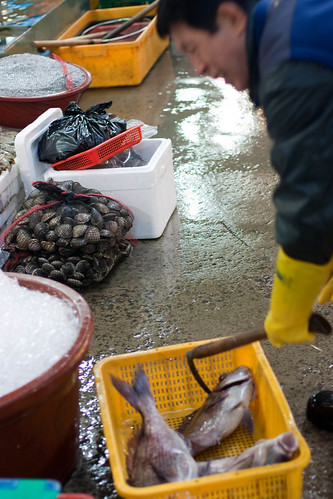
Disappointingly, some of the fish at the market are bigger than the fish at the aquarium. It's not as if they were particularly sorry specimens, but compared to the enormous squid that are lying on slabs in the market, the aquarium really wasn't making as much of an effort. I'm not saying that some high spirited Korean fisherman has done a bunk from the aquarium with a bunch of octopi under his arm, but somebody, somewhere has a better collection.
After the fish market, we had a rather long walk to Building 63, a gold coloured high rise with the world's 'tallest art gallery'. Normally I thought that art galleries were judged by the quality of the curation, whether they had a rounded collection of pieces, if they made effort towards specialising in one certain area. I'd never thought of evaluating a gallery by its altitude before. And to be fair, it is very high up.
Unfortunately, because it doubles as an art gallery and observation deck, every picture hung there has blinding reflections of the light streaming in through the windows, making it painful and difficult to look at them. There are some good pieces there though; some hyperreal pictures of Seoul where you're encouraged to spot 'the depressed man in the striped shirt who has just had a long phone call', or 'the man who has covered his face with an envelope while staring at the lady'. All good stuff – like a highbrow Where's Wally?
After the art gallery and some very strong coffee that left me doubting my own existence and the possibility of happiness, we took a taxi back to Itaewon, in search of a Buddhist restaurant that offered a fifteen course meal, including squashed tofu and watery kim chee. That didn't sound the nicest of things to me, so unadventurously we turned tail and went to a place called Gogung to have bibimbat instead.
Food inhaled, we were left with our only remaining task to do in Seoul; visit Starbucks and see what's on the menu that's different to everywhere else. Since there are Starbucks around the world, they offer a clear and distinct way into the psyche of the native populace. The latte and cappucino are like a control group, and the other things that the chain sells must be what typify that country. For example, in Hong Kong they have pineapple buns. I've never eaten a pineapple bun anywhere else (and I've never actually eaten one in Starbucks either) but it stands to reason that this must be the national dish of Hong Kong, because you only get it in Starbucks in Hong Kong, and not any other Starbucks. (Some idiot is bound to bring up dim sum at this point and suggest that's more redolent of Hong Kong than a bread product stuffed with pineapple, but they'd be wrong – after all, they don't serve dim sum in Starbucks.)
The Seoul Starbucks have cheesecake, and vegetable scones. I was obviously disappointed that there was no bibimbat, but I have to accept it; bibimbat is clearly not really Korean, otherwise it would be in the Starbucks. I'll insist on nothing apart from traditional cheesecake and vegetable scones for the rest of my time here.
Back at the hotel, I'm reading several books at once – skimming A Corkscrew Is Most Useful, and at the same time looking through a book on Chiang Kai-Shek. With the latter, I'm hunting through to find all the strange goings-on with his wife, including some kind of run-in with an American envoy in the early 1940s, that got old CKS most angry and had him running around, banging on doors and hunting for her. It's good to know that even seventy years ago, we'd successfully exported the British farce to far flung corners of the globe. (It is not recorded whether the American envoy was hiding in a wardrobe, dressed up as a vicar, but I find that if you read between the lines, that sort of detail is easily imagined. I do also imagine there were giant space-robots fighting across Manchuria by 1944, but again, no mention of that in this book. Perhaps the errata for the second edition will fix that mistake.)
Later this afternoon, after another nap, we're going to find a statue of a man hammering things. I love the fact that every large building in Seoul has to have a piece of art outside. I'm just wondering if they are in any way appropriate to the building. Most of the art seems to be innocuous but meaningless spirals, blobs or boxes (apart from the woman trapped on a rampaging horse and the giant blue Walnut Whip down the street from our hotel) but it would be helpful if the art corresponded in some way (the more literal the better) with the purpose or ownership of the building that displayed it. Or to be more honest about things, I'm hoping that the Hammering Man is battering metal outside an enormous blacksmith's, because nothing floats my boat more than random, inner-city metalwork. A full report, later.





0 comments:
Post a Comment